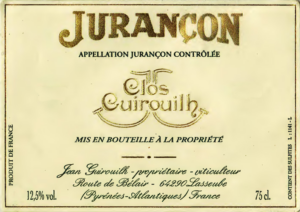Clos Guirouilh
Jurançon 2016
Clos Guirouilh Jurançon 2016
Clos Guirouilh is among the most hardcore, traditional domaines of Jurançon – a rare producer that provides us a window into the historic soul of their incredibly unique wine region. Clos Guirouilh is located around 350 meters in elevation above the village of Lasseube, in possession of the kind of terroir that is fundamental in making the truly distinctive and complex wines that Jurançon is known for.
Ten hectares of gros manseng and petit manseng vineyards are grown on calcareous clay soils with lots of yellow sandstone called grès, concentrated around the ancient farmhouse that serves as both winery and home. The vines are all in excess of forty years old and are highly trellised to take advantage of the Foehn wind off the leeward side of the Pyrenees mountains. It is this dry wind that encourages the long, even ripening cycle and creates the conditions which make multiple harvests (extending as exceptionally late as December) possible. These late, rot-free harvests are the key to the amazing concentration in the Jurançon wines.
The soils and elevations contribute to giving the wines their fresh, acidic framework for balance and complexity. Nothing at Clos Guirouilh is rushed—there are no concessions to the pace of the modern world. The wines are released when they are deemed ready to drink after a long period of cellar aging.
To make the traditional late-harvest Jurançon wine, each grape variety is picked by hand in successive passes well into December, with only perfectly healthy bunches selected. A minimum of three passes are made through the vineyards, but often many more are needed in exceptional years. Clos Guirouilh Jurançon is spontaneously fermented slowly in their ancient, cold cellar with indigenous yeasts and without temperature control. Since the cellar is already cold when the grapes come in, alcoholic fermentation crawls along until spring, when it picks back up again. The process is dictated by the pace determined by nature. The resulting wines are exactly the Jurançon we had been looking for: deeply rooted in history, uncompromising and majestic.
Vinification – Harvest is manual, with up to five passes from early November to mid-December, as the grapes dry on the vines without botrytis. In the winery, the grapes are gently crushed using a pneumatic press. The wine is fermented naturally with indigenous yeast in a mix of used barrels and stainless steel tanks. As it is already very cold in the winery by the time the must is put in barrel, fermentation happens very slowly over the course of three months. The wine is then aged for around 22 months and bottled before the next harvest. The final product has 85g/L of natural residual sugar.


